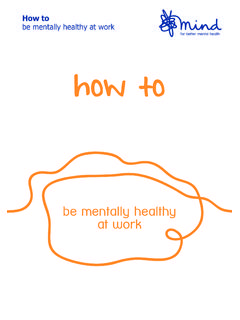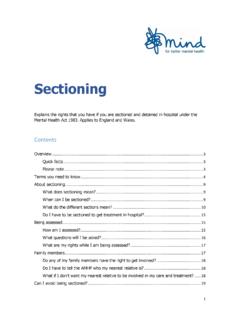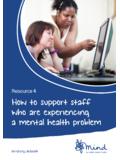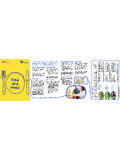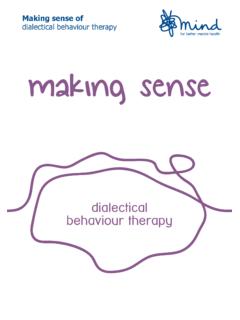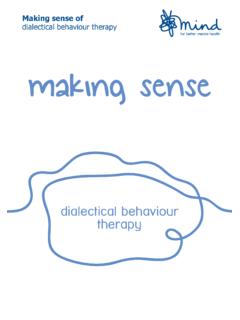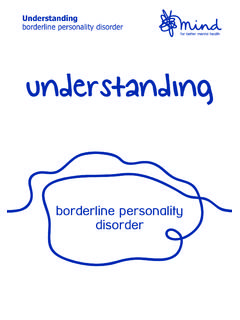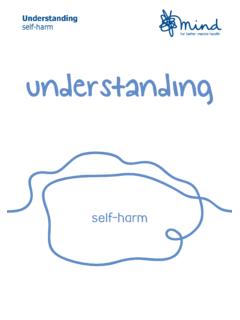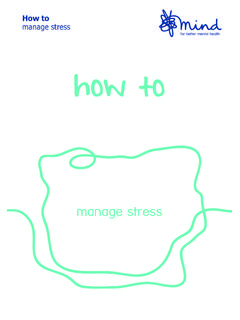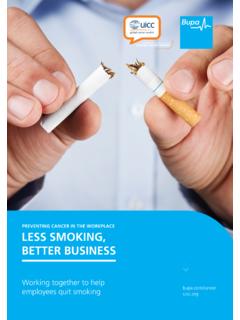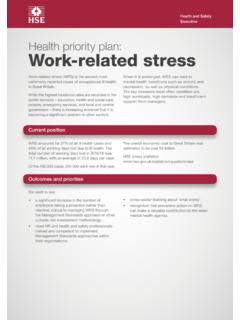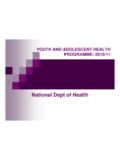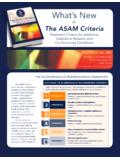Transcription of Guide December 2011 - help for mental health problems
1 Guide December 2011 . Managing and supporting mental health at work: disclosure tools for managers Contents Introduction: purpose of the disclosure tools 2. Who are the tools for? 3. What is mental health ? 4. What forms can mental health problems take? 5. Is mental health protected in law? 6. What about stress? 6. Why does mental health matter? The business case 7. Employee engagement 8. Absence 8. Presenteeism 8. Accidents 9. Staff turnover 9. Conflict at work 9. Lower insurance or risk of liability arising out of stress claims 9. Corporate governance and employer brand 9. Handling disclosure: recruitment 10. Recruitment, selection and assessment 10. Pre-employment health questionnaires 11. health questionnaires post job offer 13. Template health questionnaire 14. Prevention: keeping people well and managing stress 15.
2 Induction 15. Managing people 15. Building resilience 17. Early intervention: spotting the signs of stress and mental ill health 19. Workplace triggers 19. Early signs of mental ill health 19. Encouraging disclosure: supporting staff to stay well and in work 21. Broaching the subject 21. Responding to disclosure 23. Wellness Recovery Action Plans (WRAPs) 24. WRAP template 25. Workplace adjustments 26. Rehabilitation: supporting people to return to work 29. Return to work 30. Managing underperformance and sickness absence 32. Handling stress or mental ill health alongside disciplinary issues 33. Useful contacts 36. Acknowledgements 37. References 38. Managing and supporting mental health at work 1. Introduction: purpose of the disclosure tools promotion and career mental health Now I am working, it feels like no one is is still the elephant in the room in most workplaces.
3 Interested in me. They think I am well. I have employees are reluctant to raise the subject, for fear to hide my illness from my employer and when of discrimination, while managers often shy away I feel down I have no one to turn to. It is hard from the subject, for fear of making matters worse or to see my GP because I have to take time off provoking legal consequences. This culture of silence work and then questions will be asked. I feel means undetected mental health problems can spiral like I am trapped in a vicious circle. I need to into a crisis, resulting in sickness absence. At the other work to try to keep well, but can't access the end of the process, many employers feel uncertain services to help me keep well.'1 about changes to the law in the Equality Act around using health questionnaires during recruitment.
4 Awareness of the scale and impact of mental ill Mind and the CIPD have jointly developed these health at work is increasing in 2011 , the Chartered disclosure tools to help managers overcome these Institute of Personnel and Development (CIPD) found challenges. During our research with employers to that stress is now the biggest cause of long-term inform this work, there was a clear demand for specific sickness absence among all workers, for the first time,2 guidance on disclosure to be embedded within general while a poll by Mind revealed work is now the most guidance on mental health in the workplace to ensure stressful thing in people's lives, above money worries, the tools make practical sense in the wider marriage or relationship Employers have told As such, the tools address the whole lifecycle of Mind and the CIPD that they recognise the need to employment, from recruitment, through keeping people act on mental health but feel ill equipped to do so.
5 4. well and managing a disability or ill health at work, Disclosure is seen as the biggest barrier, creating a to supporting people to return to work after a period vicious circle' for both employees and employers. of absence. They contain information, practical advice and templates to help managers facilitate conversations Mind found that one in five workers would not about stress and mental health problems and put in disclose stress or mental health issues to their manager place support so employees can stay well and in work for fear of being placed first in line for redundancy. 5. meaning they perform at their best for the business Many staff are also reluctant to speak up about while the employer retains talent and expertise. mental health problems because it could harm their 1.
6 Unless otherwise specified, quotations throughout are from people with experience of mental health problems and employment, who have shared their stories with Mind. Steps have been taken to preserve anonymity. CIPD. ( 2011 ) Absence management survey report. 2. Populus poll for Mind of 2,006 adults in employment in England and Wales from 25 28 February 2011 , and 4 6 March 2011 . 3. This anecdotal evidence is supported by academic research, for example Brohan et al (2010) and Little et al ( 2011 ). 4. Populus poll for Mind. 5. NHS health and Wellbeing Final Report (2009). 6. Mind and the CIPD held focus groups in March 2011 to inform the development of these tools. 7. 2 Managing and supporting mental health at work Who are the tools for? We know employers come in all shapes and sizes, with different working practices and environments.
7 These tools are designed to support anyone involved in managing people, from line managers in large organisations to owner-managers of small firms. We also hope they will be a useful professional resource for HR and occupational health teams. Note that the CIPD and Mind are not providing legal advice but practical guidance employers may also need to obtain their own legal advice on the approach to take in any particular case. While the contexts will differ, we hope the principles, checklists and practical templates for facilitating conversations about mental health will be useful across the board and easily adaptable for different workplace environments and relationships. The tools can be used both as a handy aide-m moire for individual managers to consult in their day-to-day roles and incorporated into HR policies and practices to be integrated across teams and organisations.
8 So that readers can dip in and out of the sections that are relevant to them, the tools are interactive and can be flicked through in any order with ease. Managing and supporting mental health at work 3. What is mental health ? What forms can mental health problems take? Some employers have understood that having mental health problems take many forms. The terms a mental health condition is something that used to diagnose them are sometimes words that can and does get better. After all, if I had are in everyday use, such as depression' or anxiety'. epilepsy, many employers would understand This can make them seem easier to understand, but that the fits do stop and they can be triggered their familiarity can mean underestimating just how by stress. It's just the same with having bipolar severe and incapacitating these conditions may be.
9 Disorder: the best employers can see beyond a For example, employers should be mindful of the label or diagnosis to get the best from people.' difference between clinically diagnosed depression and casual use of the term to describe feeling a bit down. mental health , like physical health , can fluctuate on a spectrum from good to poor. mental health problems Below are some commonly diagnosed forms of mental can therefore affect any of us irrespective of age, health problems with examples of some of their personality or background. They can appear as a result symptoms. This is not an exhaustive list, as people will of experiences in both our personal and working react and respond differently, and men and women lives or they can just happen. One in four people can respond differently too, so it is important not to will experience a mental health problem in any given dismiss other symptoms.
10 Men are also less likely to year. Employees may be affected directly or indirectly, 8. have their problems identified early by professionals, if partners, dependants or other family members have seek help or talk to family or friends, so may not have mental health problems , which in turn impact on the a mental health diagnosis even if they are experiencing employee's own health . People can also be affected by When supporting staff, it is therefore friends' and fellow employees' experiences. important not to label people by focusing on a diagnosis. Instead, talk to them about how it impacts mental health problems can affect the way people on their work: think, feel or behave. In some cases this can seriously limit a person's ability to cope with day-to-day life, Depression very low moods; feeling hopeless, which can impact on relationships, work and quality worthless, unmotivated or exhausted; loss of of life.
